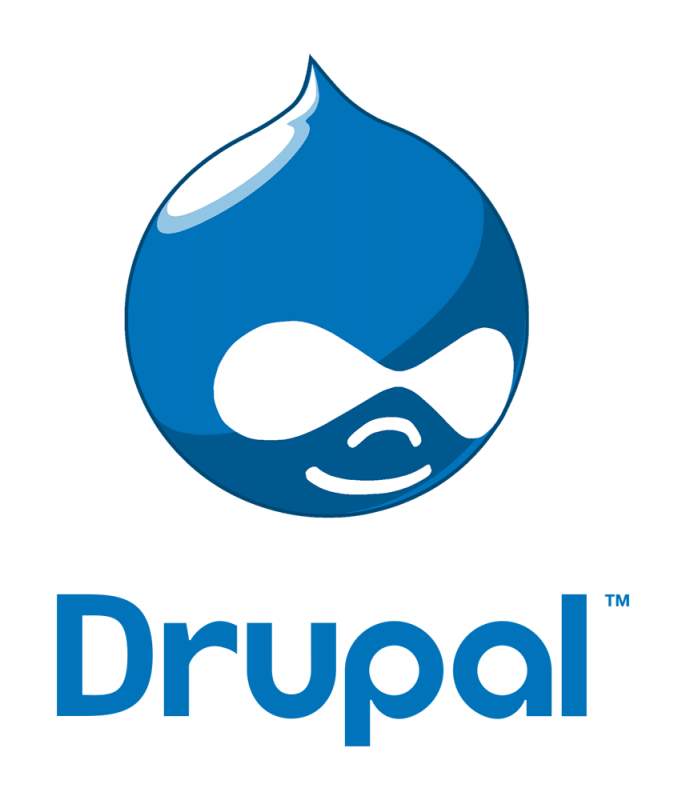Are you sometimes overwhelmed by the huge number of different martech tools?
What is a DXP? What is the difference between a CDP and a DMP? Why do I need it and what can I do with it?
Don't worry! In this handy overview you will find explanations of some important terms, as well as clear distinctions between terms where there may be some confusion.
Do you want new digital trends delivered straight to your inbox? Subscribe to our newsletter.
DXP
What is a DXP?
DXP stands for Digital Experience Platform. Gartner defines it as an integrated software framework for engaging different audiences, such as customers, employees, partners, citizens or students across multiple digital platforms. Organisations use DXPs to build, deploy and continuously improve websites, portals, mobile apps and other digital experiences.
Why is a DXP important?
The demand for relevance and a better customer experience is growing in for companies, organisations and governments alike. Websites must be an integral part of the customer journey. Therefore, there is a need for an open platform that can easily integrate with other systems and departments to create a fully personalized experience for the customer.
This is exactly what the Digital Experience Platform responds to. A few advantages:
- Stay in control of your own data
- Room for integration with new applications
- No limit on technical restrictions imposed by suppliers
- Go to market quickly with new business ideas
What can I do with a DXP?
With a DXP, you have the freedom to innovate with the fast-growing Martech industry, adding or replacing solutions and connecting the data provided, with minimal disruption to the customer experience.
According to research firm Gartner, the most important possibilities of a DXP are the following:
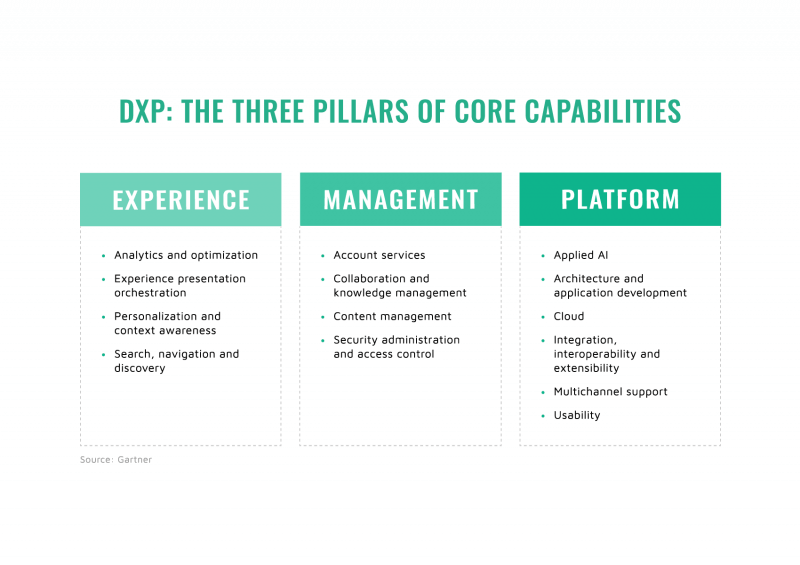
In short, a DXP manages the UX through navigation, personalization & search possibilities.
It also simplifies the management of content & security, and as a basic platform it also provides a solid architecture and the possibility to easily integrate other tools.
Discover Dropsolid Experience Cloud, an Open Source DXP.
CDP
What is a CDP?
A Customer Data Platform (CDP) integrates all relevant data sources (internal and external) with which profiles and segments can be built. Using smart models, advice can then be generated for a decision or follow-up action. Some CDPs also have the capacity to run campaigns; others can control an external system to do this, such as a marketing automation package.
Why is a CDP Important?
Using a CDP gives you a better understanding of how your customer moves and what you can do best during their customer journey to increase the likelihood of conversion. It also provides many insights into possible causes of cart or session abandonment, the best next offer to make and, for example, the importance and quality of specific contact moments.
These are gained by bringing together many different customer data sources, which leads to better insights.
What can I do with a CDP?
- Collecting data
Easily collect real-time data from your own and external sources about a visitor or customer - Profiling
Profiling based on customer and visitor attributes - Segmentation
Determine segments based on various rules, sometimes also helped by the use of various AI techniques. - Activation
From the segments used, launching actions directly to external systems, such as targeted e-mail campaigns or website personalizations.
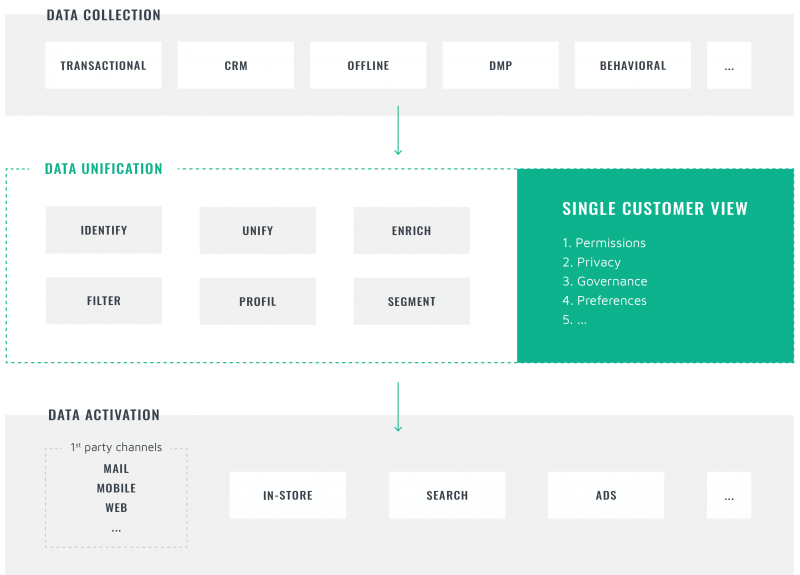
Discover the possibilities of the Apache Unomi Customer Data Platform.
Marketing Automation
What is Marketing Automation?
Marketing Automation is the use of various automated systems to acquire potential customers and help them through the customer journey. This is achieved by forwarding certain information at the right moments. The ultimate goal is to convert these leads.
Why is Marketing Automation so important?
According to Jupiter Research, relevant emails sent via marketing automation contribute 18 times more to revenue targets than non-automated emails sent to the entire customer base.
The following are some advantages of using Marketing Automation:
- Time saving through automation
Higher marketing productivity - Increase in communication speed and reduction of errors
- Cross-channel communication
- Improved conversion and higher quality of leads because relevant content reaches the right person
- Qualitative relationship with customers
Communication is tailored to the customer, ensuring a good customer experience. - Enrichment of information and data
More insights into the behaviour and needs of customers.
Thanks to Marketing Automation, can these solutions increase your sales productivity by 14.5% and reduce your marketing costs by 12.2%. Want to know how? Read it in our blog: Marketing Automation as the driver of personalized customer experiences.
What can I do with Marketing Automation?
Marketing Automation can be very useful when nurture marketing is practiced. In this way, a contact can be kept warm in the longer term on the basis of displayed behavior.
It is also useful when there are repetitive actions that can be easily automated to save time. Examples include newsletters and follow-up emails, lifecycle campaigns, queries, etc.
For large numbers of contact moments that require (personal) follow-up, marketing automation can also be applied.
A better understanding of customer needs and behavior helps to determine the most successful communication and sales strategy.
Discover the possibilities of Mautic Marketing Automation.
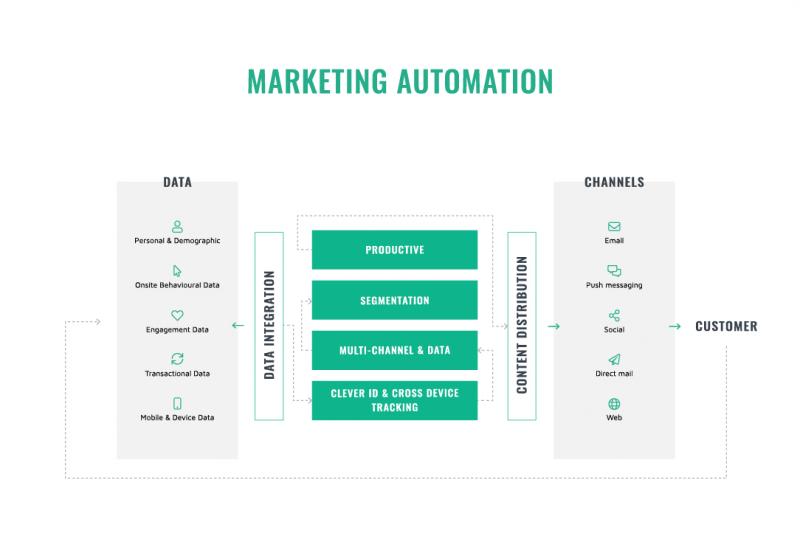
CMS
What is a CMS?
CMS stands for Content Management System and is a system behind a website that allows you to control a website easily. This simplifies the maintenance process of your website. An example of a CMS is Drupal.
Why is a CMS important?
By using a CMS, you have complete control over your website, and you are not dependent on programmers. Even without technical knowledge, you can easily add content to your website. Several people can contribute, you decide who has access to your site.
What can I do with a CMS?
With a CMS you can manage your website completely by yourself, from settings to display and structure. You can add content to your website and edit it, but you can also change the layout completely to your desire.
DMP
What is a DMP?
DMP, or Data Management Platform, is a platform for registering, centralizing, managing, and using customer and prospect data. The data that is already stored can be combined with data that the advertiser collects through interactions with the consumer. In addition, there is also enrichment by third-party data.
Why is a DMP important?
- By collecting information, marketing segmentation can be defined more accurately and more relevantly.
- Self-control of how and where your data is stored.
What can I do with a DMP?
- Personalized marketing
All first & third-party data are linked to the profile of one person. This creates a complete picture of this customer and allows personalization. As a result, advertisements can be targeted to certain groups. - Cross device & efficiency
With a DMP, information from all channels can be combined, so you can know when a consumer is exposed to or has interacted with your brand.
This way, ads can be used at the right moment. This does not only meantime but also platform. If it appears that a laptop has been purchased via an app, desktop ads are not targeted at laptops, but rather at laptop accessories, for example. - Customer analysis
The combination of data from all communication channels provides a better insight into the consumer. In this way, communication can be better geared to the target group.
DAM
What is DAM?
DAM stands for Digital Asset Management, it is an efficient solution for companies to store, manage and share digital content.
Why is a DAM important?
A DAM optimizes the digital workflow within companies. With the help of metadata, everything is easy to find. It is also often the most efficient way for a company to store content in a cost-effective way.
What can I do with a DAM?
With DAM software, you can access your digital content whenever and wherever you want.
PIM
What is PIM?
PIM stands for Product Information Management, it is a product that helps to keep all marketing, sales, and technical product information in one location. The software can synchronize data from different sources, here are some important examples: Core data: title, name, description,... Product properties: costs, prices,... Multilingual content Supplier information ...
Why is a PIM important?
A PIM system increases the efficiency of a company because the information from different sources or programs are all stored together.
What can I do with a PIM?
It creates a single place for collecting, managing and expanding your product information, creating a product catalog and distributing it to your various channels.
SEO
What is SEO?
SEO stands for Search Engine Optimisation and optimizes web pages using various methods, with the aim of increasing the organic results of search engines (= Search Engine Result Pages or SERPs).
Why is SEO important?
By making good use of SEO, you will end up higher in the search results, the chance that potential customers will notice you will increase.
Because of this higher position in the SERP, you will be able to attract more visitors to your website, as organic placement generates more traffic than advertised placement.
Not only does it generate more visitors, but these visitors also gain higher credibility of your brand. A high position radiates authority.
What can I do with SEO?
There are different ways of doing SEO, both "on-page" and "off-page". Want to know more about SEO?
SEA
What is SEA?
Search Engine Advertising means that you pay to have your web page prominently displayed in the search results of a particular search engine. When a user searches for a particular word or phrase that is being advertised, they will see an advert at the top, bottom, or side of the search results.
Why is SEA important?
With SEA, you can be found better on words that are very relevant to your business. You increase your relevance and findability, as it were, and you can measure the results of a campaign.
What can I do with SEA?
With SEA, you can sponsor Search, Display, and Video campaigns. A search campaign appears in the search results when someone searches for the advertised word or phrase. Display & Video ads are advertisements in the form of an image or video that can be placed in different places on the internet. Not only on the search results page, but also on other websites, for watching a video or in apps.
What is the difference between ...?
CDP & DMP
The main difference is that a CDP collects first-party data and its purpose is to provide insight and execution. The main differences between the two platforms can be split between data type, purpose & storage.
In terms of data, a Data Management Platform mainly collects third-party data from various sources, whereas a Customer Data Platform focuses on first-party data. A DMP has almost exclusively anonymous data and profiles are united under cookies, IP addresses, etc. A CDP, on the other hand, mainly has identified data, and all info about contacts that interact with you is also stored here.
The goal of a CDP is to create a central collection of all customer data to be used in all execution systems for personalized interaction. With a DMP, the focus is on segmenting and categorizing anonymous individuals in order to define target groups and optimize advertising.
In terms of storage, with a CDP this is in the long term, the retention of data is decided by marketing but depends on the relevance. With a DMP, this is rather short-term, with preservation of 100 days or less.
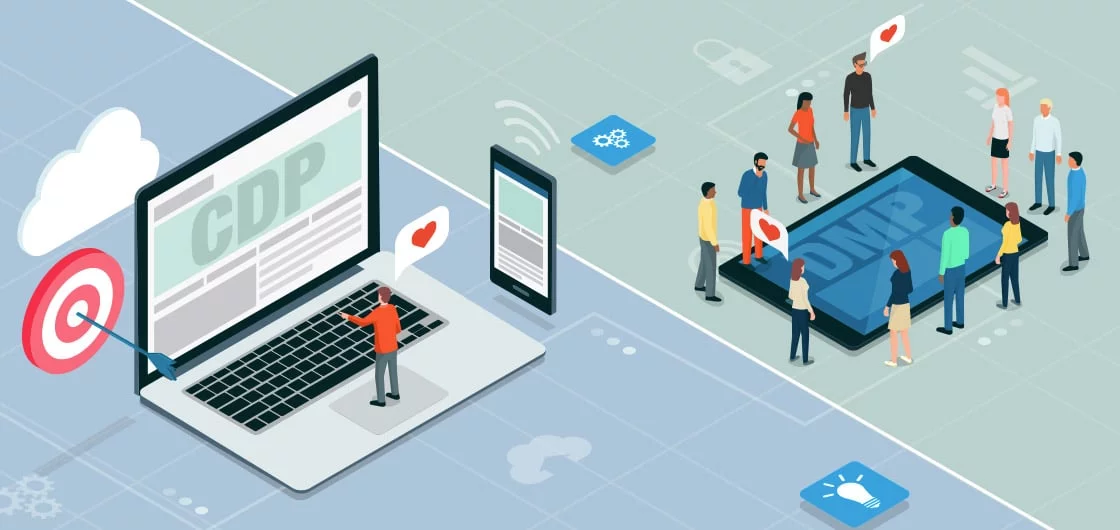
Marketing Automation & E-mail Marketing
Thanks to e-mail marketing, companies can maintain contact with prospects and customers with the main purpose of informing them. Not all emails are relevant to the recipient.
E-mail marketing is quite simple but mainly one-way, so not very connected.
Marketing Automation, on the other hand, is much more comprehensive, multi-channel, and highly connected.
The goal here is to record a prospect's online interactions in order to build a profile and communicate in a personalized manner.
In principle, e-mail marketing does not go much further than registering the interaction of a campaign, whereas with marketing automation the most important thing happens afterward. The power of automation is in bringing together all the information about the customer and using it to create relevant content in the future.
CMS & DXP
Content Management Systems focuses on content and is actually the engine of the DXP. The content created in the CMS forms the building blocks for digital experiences.
DXP Digital Expierence Platform also includes the customer dimension (with CDP) and because the two dimensions are included, you can work on a much more personal level. The DXP is actually the end-user solution; through such a platform it is possible to create unique digital experiences across different channels and optimize the customer journey through data.
This blog provides more insights into the difference between a CMS and a DXP.
Be prepared for the MarTech evolutions of 2021
Tools are the instruments to reach your goal, but you have to seize the opportunities yourself. Read here which digital opportunities you should definitely not miss in 2021!
Want to stay updated? Subscribe to our newsletter and get the latest Martech news delivered straight to your inbox!
